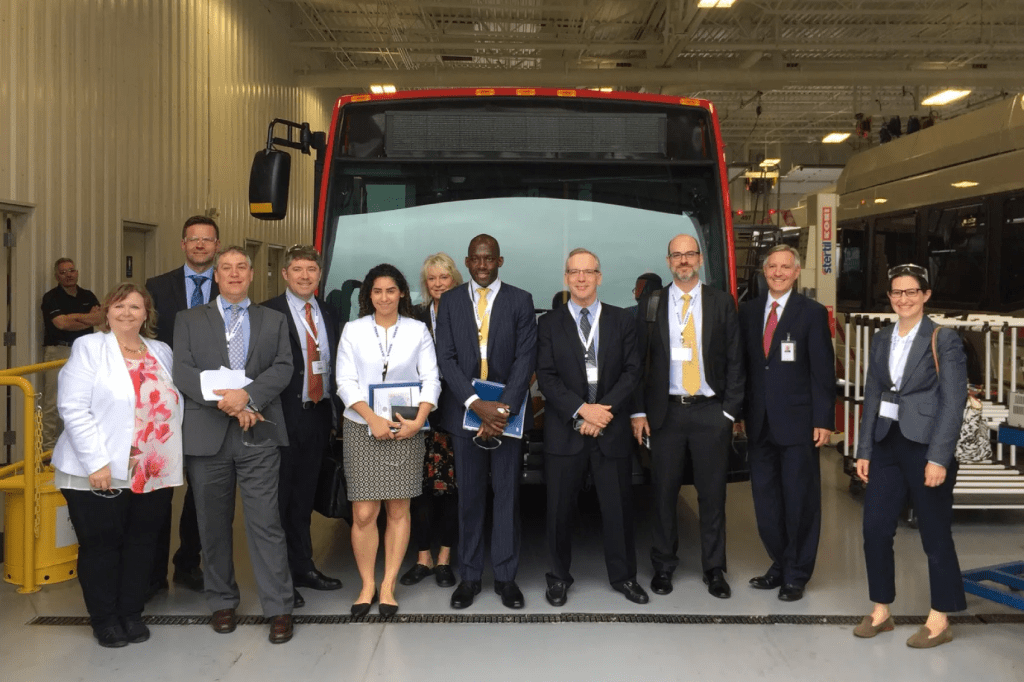
For our second regional visit of the year, we ventured about as far north as you can go in New York State, spending two days in June in the North Country region, where President Dudley and members of our staff visited Plattsburgh, Potsdam, and Fort Drum, in Jefferson County near Watertown. The local leaders we met with told us about successes and challenges alike, including the significance of having Canada as a close neighbor; concerns related to workforce development, demographics, and access to broadband; why collaboration matters for regional businesses and institutions; and how Watertown has a unique relationship with Fort Drum, a major military installation in the area.
All told, it was an informative couple of days, and we believe it’s worthwhile to share what we learned.
Integration with Canada
The North Country is bordered by Lake Ontario on the west, the Saint Lawrence River and the Canadian provinces of Ontario and Quebec on the northwest and north, and Lake Champlain and Vermont on the east. An important aspect of the regional economy is how integrated it is with Canada — perhaps not surprising given the close geographical proximity. This relationship is evident in many areas of the economy, such as manufacturing and trade, tourism, and even commuting for work or pleasure. We spoke with people who mentioned how easy it is to drive across the border for dinner or have a second home in the neighboring country.
In the context of manufacturing, Garry Douglas, President of the North Country Chamber of Commerce, described the link between the U.S. and Canada as a “post-trade” relationship, noting that the two countries have moved beyond trade and have fully integrated economies in which they are making things together. As a result, a liberal immigration and trade regime is important, given that cross-border flows of people and materials enable the production of goods and services on both sides. To that end, members of the Plattsburgh business community see NAFTA as a net positive for the region.
There are more than 30 transportation equipment companies in the North Country region, with a majority clustered in Plattsburgh, including major U.S. facilities for Bombardier and Nova Bus, two large Canadian firms. During a meeting in Plattsburgh, several business leaders described the current environment as a renaissance, noting that Plattsburgh is experiencing significant growth in manufacturing and that grant monies channeled through the North Country Regional Economic Development Council have sparked enthusiasm and renewed energy in the community. The transportation manufacturing sector, which has grown more than 40% since 2010, employs more than 8,000 residents and pays higher-than-average wages for the region, according to an Empire State Development report.

Workforce and Demographic Trends
Still, the North Country region faces challenges related to workforce readiness and demographics. Bus manufacturer Nova Bus is heavily invested in Plattsburgh, where its assembly plant employs 295 workers. During a meeting with senior leaders, we learned that while the company plans to expand, finding and recruiting talent to the region is a concern. Meanwhile, at Bombardier, which produces rail cars at its Plattsburgh plant, officials explained that the company struggles to find welders and engineers.
At a roundtable discussion in Plattsburgh, local community leaders expressed concern about the quality of workers available in the region, noting examples where they lack basic skills or have trouble getting to work on time (or sometimes do not show up at all). They also said that while high school graduation rates have increased, so have college dropout rates. There appears to be a real need for more training to ensure that workers are equipped with basic skills and that those skills match the available jobs.
Organizations in the region are working to support the growth in the manufacturing sector, by ensuring that there is a pipeline of skilled local workers. In the spring of 2016, Clinton Community College broke ground on a facility to house the Institute for Advanced Manufacturing. Clinton Community College is partnering with several other local institutions on this project, including SUNY Plattsburgh, Clarkson University, the North Country Regional Chamber of Commerce, and the North Country Workforce Development Institute.
In terms of broader demographic challenges, the region consists mostly of rural areas of low density. In fact, while the North Country is geographically the largest region in New York State, it is also the most sparsely populated, with just 2.2% of the state’s residents. And we heard on our visit that a declining population is a real concern for the region. Further, while the North Country is home to many institutions of higher education, the consensus is that there is a “youth drain,” as not many students choose to stay in the area after graduation.
Meanwhile, other barriers to economic growth and stability in the region include a lack of access to broadband, transportation, and capital.
Broadband Challenges
At a meeting at Clarkson University in Potsdam, the discussion centered on why access to broadband internet is critical for communities in the North Country. Broadband investment has been particularly challenging in the region due to the natural topography and the lack of population density. Economies of scale that make serving a city economically viable for a broadband service provider do not exist in a sparsely populated region. And while it might be easy to serve the “downtown” area of a small town in a rural area, there is a “last mile” problem with respect to reaching homes that are more widely dispersed.
This lack of access has implications for students, businesses, public safety, tourism, and employment. Students without internet at home must go to the library or another location to do homework. For businesses, a lack of internet access is a competitive disadvantage. We heard one example of a saw mill that was unable to modernize because some of the latest equipment is web-based. Likewise, public safety agencies may find themselves unable to upgrade their technologies, meaning residents could be at risk. And the tourism economy in the region also could be hurt, as visitors who are accustomed to having service may reconsider their visit if they cannot get online for directions and other services.
In terms of employment, one consideration is what the dearth of broadband access means for firms that are trying to recruit workers from outside the area. A potential employee who would be relocating might have a spouse who would seek to work from home. Yet limited internet access constrains such possibilities. And perhaps most importantly, a lack of internet availability has negative implications for anyone seeking employment in today’s world. As one person said at our roundtable discussion, “You have to be online to get the next job.”
Transportation Limitations
Another challenge for the local economy is a lack of public transportation infrastructure, which affects workers, students, and visitors seeking to vacation or do business in the area. As in other parts of the country, displaced workers face difficulty finding jobs in a shrinking local economy, and that problem is exacerbated by long distances between economic hubs in such a large and sparely populated area.
During our discussions, we heard about one local company that arranged to bus workers in from another county after it was unable to find local labor and it became clear that workers were unable to make the trip themselves. In Potsdam, leaders from five of the region’s higher education institutions said that the lack of infrastructure continues to be a challenge and could discourage enrollment, given that transportation is difficult for students who do not own cars.
Businesses also recognize the need to ensure that the region is accessible to outsiders, and there are plans that focus investment on redevelopment of the local airports. To that end, New York State recently awarded Plattsburgh International Airport $38 million to transform the former Air Force base into a transportation and economic development hub for the North Country region.

Access to Capital
In several meetings, we heard that access to capital is critical for economic development. During a business roundtable meeting, we learned about increasing instances of entrepreneurship, especially in agriculture-related areas such as wine, beer, and cheese. We also heard that entrepreneurship could be a new economic driver for the region, given that small businesses are critically important in a region where the addition of 10 or 20 jobs can have a real impact. Leaders from the local higher education institutions said they are building out support systems to encourage entrepreneurship among students.
We also learned of difficulties in credit intermediation. A senior executive from a local financial institution said that while their business loan portfolio was up 12% this year, 8% of the loans were going to businesses outside of the North Country region. So while local financial institutions may have the appetite to lend, opportunities to do so within the region may be scarce. That could indicate a need for additional education and counseling for small business owners.
Cooperative Spirit
Finally, a unique characteristic of the North Country is the high level of collaboration among regional institutions. The North Country Regional Economic Development Council (REDC) has helped increase levels of integration and collaboration across municipalities and institutions. The five local colleges are all involved in the REDC, and we learned that they often work together on student programming, transportation, and integrated course offerings to mitigate the challenges of being geographically isolated.
Fort Drum’s relationship with Jefferson County is another example of collaboration. The military base is very integrated with the county’s infrastructure. For one, the schools and hospitals are local institutions — there are not separate facilities for the base. Physician soldiers help staff the local hospitals. At Jefferson Community College, military personnel account for 41% of the student population. Also, all housing on the installation is private, giving residents a stake in the base, and vice versa. As part of an effort to track its economic impact, Fort Drum has found that hundreds of millions of dollars of investment since 1988 has helped to attract new business to the county and diversify the workforce.
On this visit — our first to the North Country — we met with more than 50 community leaders, who provided us with insight into the region’s challenges and opportunities. Despite the challenges, most community leaders we met were optimistic about the future. Our conversations were fruitful, as we already have plans to return to Clarkson University in August to host a follow-up to our discussion on broadband investment and infrastructure.
Learn more about the purpose of the New York Fed’s regional visits and what we heard on our first trip this year, to Queens.
This article was originally published by the New York Fed on Medium.
The views expressed in this article are those of the contributing authors and do not necessarily reflect the position of the New York Fed or the Federal Reserve System.










